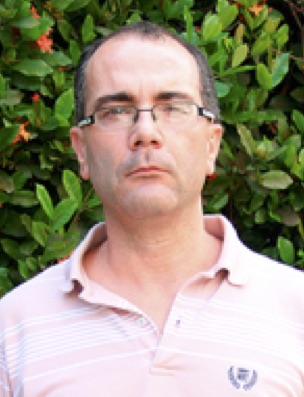Org. Synth. 2018, 95, 192-204
DOI: 10.15227/orgsyn.095.0192
Preparation of N-(1,7,7-Trimethylbicyclo[2.2.1]heptan-2-ylidene)nitramide
Submitted by Emerson Teixeira da Silva, Adriana Marques Moraes, Adriele da Silva Araújo, and Marcus Vinícius Nora de Souza
1*
Checked by Philipp C. Roosen, Christopher J. Borths, and Margaret M. Faul
1. Procedure (Note 1)
A.
1,7,7-Trimethylbicyclo[2.2.1]heptan-2-one oxime (1). A 250 mL three-necked, round-bottomed flask containing a stir bar is equipped with a condenser, internal thermometer and glass stopper under nitrogen atmosphere. The flask is charged with
D-camphor (11.0 g, 99.0 wt%, 71.6 mmol) (
Note 2) and
ethanol (36 mL) (
Note 3), and the solution is stirred at 24 °C until the solid dissolves. Deionized water (55 mL) is added to the stirring solution (
Note 4) followed by
hydroxylamine hydrochloride (7.83 g, 112.7 mmol, 1.6 equiv) (
Note 5) and
sodium acetate (7.46 g, 90.9 mmol, 1.3 equiv) (
Note 6). The flask is placed into an aluminum heating block set to 60 °C. The reaction is stirred overnight until TLC indicates complete consumption of the starting material (
Note 7) (Figure 1).
Figure 1. Reaction in progress
The solution is cooled to room temperature and concentrated in vacuo by rotary evaporator (30 mL volatiles are collected at 25 °C and 20 mmHg). The contents are extracted with
diethyl ether (3 x 50 mL) in a 250 mL separatory funnel. The organic phases are combined, dried over anhydrous
sodium sulfate (15 g) and filtered into a 250 mL one-necked round-bottomed flask. Volatiles are removed in vacuo (25 °C, 10 mmHg) to furnish a white solid that is dried under vacuum (10 mmHg) for 1 h, furnishing 12.6 g of crude material. The solid is dissolved in hot
ethanol (15 mL, 75 °C) and vacuum filtered through a 30 mL fine-fritted funnel into a 50 mL one-necked round-bottomed flask. The filtrate is cooled to room temperature (24 °C) and then stored at 4 °C overnight. The resulting crystals are collected by suction filtration on a Büchner funnel, washed with cold
ethanol (10 mL, 0 °C), and then transferred to a tared 100 mL round-bottomed flask and dried at 10 mmHg overnight to provide 6.90 g (56%) of white crystals (Notes
8 and
9) (Figure 2).
Figure 2. Recrystallized oxime 1
B
. N-(1,7,7-Trimethylbicyclo[2.2.1]heptan-2-ylidene)nitramide(2). A 50 mL, two-necked round-bottomed flask, equipped with a 1-cm Teflon-coated magnetic stir bar, a pressure-equalizing addition funnel, and an internal thermometer is charged with
oxime (2.0 g, 11.98 mmol) (
Note 10) and
acetic acid (10 mL). The mixture is stirred until homogenous (
Note 11) under room temperature (24 °C) conditions. Aqueous
sodium nitrite (11 mL 15 wt%, 24.0 mmol) (
Note 12) is added drop-wise by addition funnel over 10 min (
Note 13).
Figures 3 and 4. Initial addition of nitrite sodium solution and a color change
During and after the addition the internal temperature does not exceed 27 °C, and the color of the medium changes from translucent to pale yellow (Figures 3 and 4).
The temperature of the solution is maintained at room temperature, (24-27 °C) for 16 h at which time TLC analysis indicates complete consumption of the starting material (
Note 14). During the reaction the color of the solution changes from yellow to pale white (Figures 5 and 6). The solution is then cooled in an ice bath. To this solution is added 12.5 M NaOH solution (13 mL) (
Note 15) over the course of 1-2 min until the solution becomes basic (pH 12) (
Note 16), after which distilled water (5 mL) is added. The solution is extracted with ethyl ether (3 x 20 mL) using a 125 mL separatory funnel. The organic phases are combined, dried over anhydrous
sodium sulfate (10 g) and filtered into a 125 mL tared, one-necked round-bottomed flask. The solution is concentrated in vacuo (25 °C, 75 mmHg). The product is dried under vacuum (0.01 mmHg) (Figure 7) for 16 h to deliver 2.1 g (87%) of camphor nitro-imine as a yellow solid (Notes
17 and
18).
Figures 5 and 6. Reaction under stirring with a color change
Figure 7. Product after work-up under high vacuum
2. Notes
1. Prior to performing each reaction, a thorough hazard analysis and risk assessment should be carried out with regard to each chemical substance and experimental operation on the scale planned and in the context of the laboratory where the procedures will be carried out. Guidelines for carrying out risk assessments and for analyzing the hazards associated with chemicals can be found in references such as Chapter 4 of "Prudent Practices in the Laboratory" (The National Academies Press, Washington, D.C., 2011; the full text can be accessed free of charge at
https://www.nap.edu/catalog/12654/prudent-practices-in-the-laboratory-handling-and-management-of-chemical. See also "Identifying and Evaluating Hazards in Research Laboratories" (American Chemical Society, 2015) which is available via the associated website "Hazard Assessment in Research Laboratories" at
https://www.acs.org/content/acs/en/about/governance/committees/chemicalsafety/hazard-assessment.html. In the case of this procedure, the risk assessment should include (but not necessarily be limited to) an evaluation of the potential hazards associated with
D-camphor,
ethanol,
hydroxylamine hydrochloride,
sodium acetate,
diethyl ether,
acetic acid,
sodium nitrite,
sodium hydroxide, and
sodium sulfate.
2. The checkers purchased
D-camphor (≥97%, FG) from Aldrich.
3. The authors used
ethanol (96%) from Synth (Brazil) as received. The checkers used 200 proof
ethanol from Decon labs.
4.
Camphor precipitates out upon addition of water, but it redissolves upon warming.
5.
Hydroxylamine hydrochloride (98%) from Aldrich was used as received. The use of 2.5 equiv is important for total consumption of starting material.
6.
Sodium acetate from JT Baker (ACS reagent) was used as received.
7. The reaction may be heterogenous. The reaction was monitored by TLC analysis on Merck silica gel 60 F254 plates developing with hexanes/ethyl acetate (10:1). The R
f values of
oxime 1 and
camphor are 0.29 and 0.64, respectively. Visualized with a 10 %
ethanol solution of phosphomolybdic acid (PMA). After dipping the TLC plate to the PMA solution, the plate is developed by heating.
8. A second reaction on the same scale provided 7.31 g (60%) of the identical product with > 99% purity.
9.
Oxime 1: Purity of 99% was determined by qNMR using guaiacol as an internal standard. mp 116-117 °C (lit
2 119-121 °C). [α]
20D = - 40.3 (c=1, EtOH).
1H NMR
pdf(CDCl
3, 400 MHz) δ: 0.80 (s, 3H), 0.92 (s, 3H), 1.01 (s, 3H), 1.16-1.28 (m, 1H), 1.42-1.52 (m, 1H), 1.70 (td,
J = 12.2, 4.2 Hz, 1H), 1.79-1.90 (m, 1H), 1.92 (t,
J = 4.3 Hz, 1H), 2.06 (d,
J = 17.8 Hz, 1H), 2.55 (dt,
J = 17.8, 3.8 Hz, 1H), 8.93 (s, 1H).
13C NMR
pdf(100.6 MHz, CDCl
3) δ: 11.1, 18.5, 19.4, 27.2, 32.6, 33.0, 43.7, 48.3, 51.8, 169.9. IR 3287, 2958, 1686 cm
-1.
10.
Oxime was prepared as described above, but the
oxime can also be purchased from commercial sources.
11.
Acetic acid was obtained from Aldrich, with purity of 98% and was used as received.
12.
Sodium nitrite (99%) was obtained from Sigma-Aldrich Co. (USA) and used as received.
13. The release of nitrous gas occurred without any problem, however the reaction was performed in the fume hood. The use of 2.0 equiv of NaNO
2 is important for total consumption of starting material in this time and temperature.
14. The reaction progress was monitored by TLC analysis on Merck silica gel 60 F254 plates developing with hexanes/ethyl acetate (10:1). The R
f values of
oxime 1 and nitro-imine
2 are 0.29 and 0.67, respectively. Visualized with a 10 %
ethanol solution of phosphomolybdic acid (PMA). After dipping the TLC plate to the PMA solution, the chromatogram is stained by heating. Only nitro-imine is visible with UV 254 nm lamp.
15.
Sodium hydroxide (98%) was obtained from Aldrich and used as received in the preparation of the solution, as follows. To a graduated Erlenmeyer flask of 500 mL was added NaOH (250 mL). Distilled water was added slowly, with magnetic stirring, until the targeted volume (500 mL) was achieved. Cooling was necessary because the dissolution is exothermic. After total dissolution, the solution was allowed to warm to room temperature prior to use. The checkers added water (15 mL) rapidly to NaOH (12.5 g, 313 mmol) with magnetic stirring and diluted the solution to the target volume of 25 mL after the solution cooled to room temperature.
16. The pH of the solution between 12 and 14 is sufficient. Other bases, such as carbonate, can be used, but care must be taken due to the release of gases.
17. A second reaction on the same scale provided 2.26 g (90%) of the identical product with > 97% purity.
18. Nitro-imine
2: Purity of 97% was determined by qNMR using guaiacol as the internal standard; mp 34-37 °C, although the submitters report formation of a light yellow oil at rt. [a]
20D -26.9 (c=1, EtOH).
1H NMR
pdf(CDCl
3, 400 MHz, mixture of isomers E:Z, 17:1) δ: 0.89 (s, 3H), 0.99 (s, 3H), 1.05 (s, 3H), 1.27-1.37 (m, 1H), 1.51-1.62 (m, 1H), 1.80-1.99 (m, 2H), 2.04 (t,
J = 4.4 Hz, 1H), 2.13 (d,
J = 18.7 Hz, 1H), 2.69 (ddd,
J = 18.6, 4.7, 2.4 Hz, 1H).
13C NMR
pdf(100 MHz, CDCl
3) δ: 10.3, 18.6, 19.4, 26.7, 31.5, 35.1, 43.4, 48.8, 54.1, 189.4, IR: 2965, 1643, 1554, 1332 cm
-1. The product is stable at room temperature, but it is recommended to store the material at refrigerated temperature. Further purification is not necessary.
Working with Hazardous Chemicals
The procedures in
Organic Syntheses are intended for use only by persons with proper training in experimental organic chemistry. All hazardous materials should be handled using the standard procedures for work with chemicals described in references such as "Prudent Practices in the Laboratory" (The National Academies Press, Washington, D.C., 2011; the full text can be accessed free of charge at
http://www.nap.edu/catalog.php?record_id=12654). All chemical waste should be disposed of in accordance with local regulations. For general guidelines for the management of chemical waste, see Chapter 8 of Prudent Practices.
In some articles in Organic Syntheses, chemical-specific hazards are highlighted in red "Caution Notes" within a procedure. It is important to recognize that the absence of a caution note does not imply that no significant hazards are associated with the chemicals involved in that procedure. Prior to performing a reaction, a thorough risk assessment should be carried out that includes a review of the potential hazards associated with each chemical and experimental operation on the scale that is planned for the procedure. Guidelines for carrying out a risk assessment and for analyzing the hazards associated with chemicals can be found in Chapter 4 of Prudent Practices.
The procedures described in Organic Syntheses are provided as published and are conducted at one's own risk. Organic Syntheses, Inc., its Editors, and its Board of Directors do not warrant or guarantee the safety of individuals using these procedures and hereby disclaim any liability for any injuries or damages claimed to have resulted from or related in any way to the procedures herein.
3. Discussion
The nitro-imine
2 is a versatile precursor for a preparation of various compounds of interest in organic synthesis, as auxiliary chiral,
2 bioactive compounds
4 and others.
5,6 In our research group it has been utilized for obtaining diverse bioactive compounds
7 with appreciable biological activities. Literature reports that
2 has been obtained from
oxime 1 in reasonable scale in long reaction times, utilizing large quantities of solvents and reagents, with only modest yields (60-70%). Nitro-imine
2 has been prepared from the
oxime using
diethyl ether, H
2SO
4, and NaNO
2 in a procedure
4 that includes a complicated isolation procedure and difficult purification. In other work, compound
2 was prepared from the
oxime using NaOCl,
6 which resulted in a product with poor purity and low yield.
Page, et al,
2. described the synthesis using NaNO
2 and AcOH in large excess. In this procedure, the authors used excess of NaNO
2 (1.8 equiv; 5% solution) and a large volume of AcOH (900 mL for 30 g of the
oxime), making the medium very dilute, and causing a longer reaction time and lower yield. Following this protocol, we obtained the product only after 20h of reaction at room temperature.
Examples of Use of the Nitro-imine 2
Page, et al.
2 described the first stable chiral oxaziridine
3 from nitro-imine
2 (Scheme 1). Oxaziridines are known to induce amination of nitrogen, sulfur and carbon nucleophiles, as well as aziridination of alkenes and amination of enolates. The oxaziridine
3 was converted to compounds
4a-4e, with oxidant properties, by derivatization of the nitrogen atom. The known asymmetric oxidant
N-phenylsulfonyloxaziridine
4b was prepared as a single diastereoisomer.
Scheme 1. Synthesis of stable oxaziridines from 2
Squire, et al.
4b has reported on the synthesis of chiral, non-racemic
vic-amino-alcohols derived from
D-camphor as a potential chiral auxiliary for asymmetric synthesis (Scheme 2).
Scheme 2. Formation of vic-amino-alcohols
In initial experimentation the authors attempted to condense
D-camphor with the amino alcohol (1
R,2
S)-norephedrine under harsh conditions to obtain the respective imine derivative in poor yield. To circumvent this issue nitro-imine
2 was used to promote the formation of desired imines that were reduced to the amino-alcohols
6.
Nickerson, et al.
5 has identified nitro-imines as impressive starting points for the syntheses of otherwise inaccessible, sterically encumbered enamines (Scheme 3). In this work authors prepared various nitro-imines, among these, the nitro-imine
2 derived from camphor. The activation of nitro-imines with urea catalysts for reaction with a variety of amines enables the formation of highly substituted enamines. For example, formation of compounds
7a-
7c were described in this paper (Scheme 3).
Scheme 3. Synthesis of enamines by activation of 2
Starting from
2, our research group has synthesized and evaluated various camphor imine
8 and hydrazone
10 derivatives as potential antitubercular, anticancer and antiviral agents (Scheme 4).
7 Many of these compounds has reasonable activity against
Mycobacterium tuberculosis and the compound
8 (R= 2-HO-Ph) showed the highest activity with MIC=3.12 (minimal inhibitory concentration), comparable to ethambutol, a classical anti-TB agent.
Scheme 4. Synthesis of biological active camphor derivatives
Appendix
Chemical Abstracts Nomenclature (Registry Number)
Sodium hydroxide: sodium, hydroxide (1310-73-2)
Sodium nitrite: sodium, nitrite (7632-000-0)
Acetic acid: acetic acid (64-19-7)
D-Camphor: 1,7,7-Trimethylbicyclo[2.2.1]heptan-2-one (464-49-3)
Oxime 1: 1,7,7-Trimethylbicyclo[2.2.1]heptan-2-one oxime (1) (37850-13-8)
Nitro-imine 2: N-(1,7,7-Trimethylbicyclo[2.2.1]heptan-2-ylidene)nitramide (2) (114717-12-3)

|
Marcus Vinícius Nora de Souza is a senior technologist at Fiocruz, and leads a research group in organic chemistry, with emphasis in organic synthesis and medicinal chemistry, acting on neglected diseases (tuberculosis and malaria), cancer and synthetic methodologies. He has authored more than 250 manuscripts, 5 patents and 3 books, and their formation includes a Ph.D. in organic and bioorganic chemistry (Universite de Paris XI (Paris-Sud) - France) with stage at the University of Barcelona - Spain, and three postdocs in organic synthesis and medicinal chemistry (University of Florida - USA, Federal University of Juiz de Fora - MG, Pharmaceutical industry Genzyme - Boston - USA). |

|
Emerson Teixeira da Silva received his PhD in UFRJ in 2004. He is a Technologist in Research at Fiocruz, and works with organic chemistry, with emphasis in organic synthesis and medicinal chemistry, acting on neglected diseases, cancer and asthma. He has authored more than 10 patents deposited in various countries and various published manuscripts. He worked with process chemistry in chemical industry. |

|
Adriana Marques Moraes is a postgraduate student at UFRJ in Chemistry and develops the experimental part of her work at Fiocruz. She has worked in the area of organic synthesis since her graduation and has co-authored publications in the field. She is interested in bioactive synthetic compounds and natural products. |

|
Adriele da Silva Araújo is an undergraduate student at UFRJ in Chemistry and develops scientific research at Fiocruz since the secondary education. She has worked with organic synthesis and has authored publication. She is interested in bioactive synthetic compounds and organic synthesis. |

|
Philipp C. Roosen obtained a B.A. in biology from Albion College and an M.S. in chemistry exploring ortho-directed Ir-catalyzed C-H borylations of arenes with Professor Milton Smith and Professor Robert Maleczka at Michigan State. He studied natural product synthesis at the University of California Irvine with Professor Christopher Vanderwal, focusing his Ph.D. dissertation on the synthesis of 7,20-diisocyanoadociane. In 2016 he joined the Pivotal Drug Substance Technology organization at Amgen where he is involved in the development of pharmaceutically relevant chemical processes. |

|
Christopher J. Borths earned a Ph.D. in synthetic organic chemistry from the California Institute of Technology in 2004 for developing novel organocatalytic methods with Prof. David MacMillan. After completing his graduate studies, he joined the Chemical Process Research and Development Group at Amgen. He is currently a Principal Scientist in the Synthetic Technologies and Engineering group within the Pivotal Drug Substance Technology department where he works on the development of robust and safe manufacturing processes to produce active pharmaceutical ingredients, including traditional synthetic small molecule drugs, antibody-drug conjugates, and oligonucleotide therapeutics. |
Copyright © 1921-, Organic Syntheses, Inc. All Rights Reserved